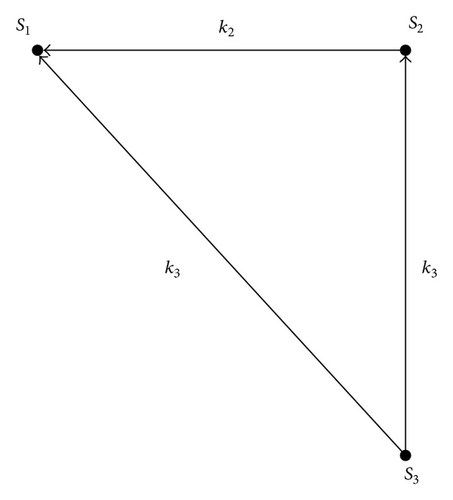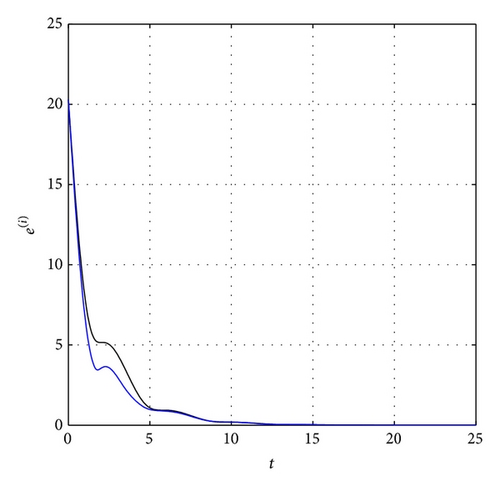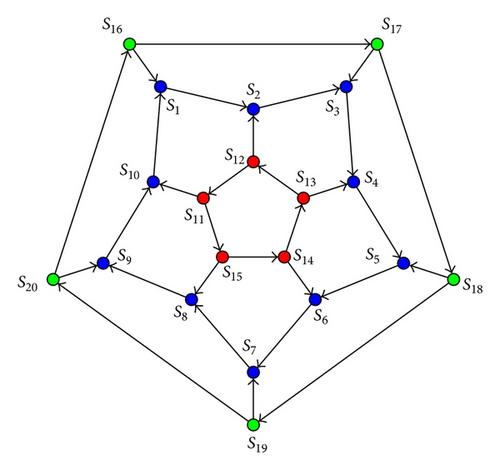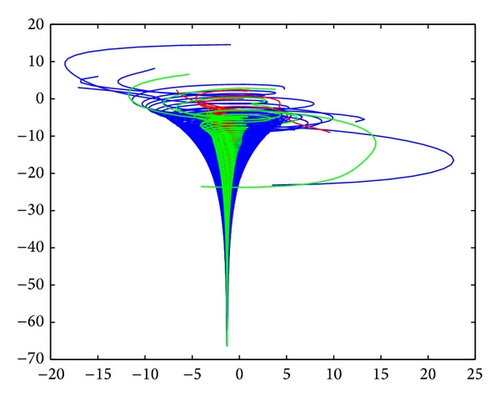Static Consensus in Passifiable Linear Networks
Abstract
Sufficient conditions of consensus (synchronization) in networks described by digraphs and consisting of identical deterministic SIMO systems are derived. Identical and nonidentical control gains (positive arc weights) are considered. Connection between admissible digraphs and nonsmooth hypersurfaces (sufficient gain boundary) is established. Necessary and sufficient conditions for static consensus by output feedback in networks consisting of certain class of double integrators are rediscovered. Scalability for circle digraph in terms of gain magnitudes is studied. Examples and results of numerical simulations are presented.
1. Introduction
Control of multiagent systems has attracted significant interest in last decade since it has a great technical importance [1–5] and relates to biological systems [6].
In consensus problems agents communicate via decentralized controllers using relative measurements with a final goal to achieve common behaviour (synchronization) which can evolve in time. Many approaches have been developed for different problem settings.
Laplace matrix, its spectrum, and eigenspace play crucial role in description and analysis of consensus problems. Laplace matrix has broad applications, for example, [7]. Not all possible digraph topologies can provide consensus over dynamical networks. Admissible digraph topologies and connection with algebraic properties of Laplace matrix have been found in [8]. Tree structure analysis and properties of Laplace matrix spectrum of digraphs are also studied by these authors. Work [9] contains examples of out-forests as well as useful graph theoretical concepts and can be recommended as an entry reading to the research of these authors on algebraic digraph theory and consensus problems.
Concept of synchronization region in complex plane for networks consisting of linear dynamical systems is introduced in [10]. In [11] this concept is used for analysis of synchronization with leader. Problem is solved using Linear Quadratic Regulator approach in cases when full state is available for measurement and when it is not. In the last case observers are constructed.
Analysis of consensus with scalar coupling strengths [10, 11] is fruitful in a sense that conditions on gains (which depend on connection topology and single agent properties) give more insight to problem. A lot of works on topic consider dynamic couplings; however, for certain type of connections it might happen that tunable parameters will exceed upper bound on possible control gains, that is, not meet physical limitations. So, necessary and sufficient conditions on consensus achievement for different connection types in terms of coupling strengths are needed.
Celebrated Kalman-Yakubovich-Popov Lemma (Positive Real Lemma) establishes important connection between passivity (positive-realness) of transfer function χ(s) and matrix relations on its minimal state-space realization (A, B, C); see [12, 13]. Positive Real Lemma is a basis for Passification Method [14, 15] (“Feedback Kalman-Yakubovich Lemma”) which answers question when a linear system can be made passive, that is, strictly positive real (SPR) by static output feedback. Powerful idea of rendering system into passive by feedback has been also studied for nonlinear systems, for example, [13, 16, 17].
In consensus-type problems considering SPR agents with stable (Hurwitz) matrix A leads to a synchronous behaviour when all states go to zero. The latter is undesirable in essence, since such behaviour can be reached by local control without communication. So, instead of SPR systems it is possible to consider passifiable systems, with an opportunity that a study is extendable to nonlinear systems. Also, Passification Method allows avoiding constructing observers for reaching full-state consensus by output feedback. Observers implementation increases dimension of overall phase space and complexity of a dynamic network. However, finding a passification matrix (vector g) is long standing open problem; still set of passifiable systems is nonempty.
In this paper Passification Method is used to synthesize a decentralized control law and to derive sufficient conditions of full-state synchronization by relative output feedbacks in networks described by digraphs with Linear Time Invariant dynamical nodes in continuous time. Assumptions made on network topology are minimal. Synchronous behaviour is described, including case of nonidentical gains. It is determined that boundary of sufficient gain region geometrically is a hypersurface in corresponding gain space. For certain three-node network this geometrical observation connects algebraic properties of Laplace matrix with constructed hypersurface. Namely, Jordan block appears in a direction of a cusp (nonsmooth) extremal point of the hypersurface.
Necessary and sufficient conditions for static consensus by output feedback in networks consisting of certain class of double integrators have been rediscovered. Conditions are given in terms of Laplace matrix spectrum.
Scalability in a circle digraphs in terms of gain (coupling strength) is studied. It is shown that common gain in large cycle digraphs consisting of double integrators should grow not slower than quadratically in number of agents.
Results of numerical simulations in 3- and 20-node double-integrator networks are presented.
Neighbouring papers, which influenced this work, are cited before Conclusions.
2. Theoretical Study
2.1. Preliminaries and Notations
Notations, some terms of graph theory, and Passification Lemma are listed in this section.
2.1.1. Notations
Notation ‖·‖2 stands for Euclidian norm. For two symmetric matrices M1, M2 inequality M1 > M2 means that matrix M1 − M2 is positive definite. Notation col(v1, …, vd) stands for vector (v1, …, vd) T. Identity matrix of size d is denoted by Id. Vector 1d = (1,1, …, 1) is vector of size d and consisting of ones. Vector 0d is defined similarly. Matrix diag(v1, …, vd) is square matrix whose ith element on main diagonal is vi, i = 1, …, d; other entries are zeroes. Notation ⊗ stands for Kronecker product of matrices. Definition and properties of Kronecker product, including eigenvalues property, can be found in [18, 19]. Direct sum of matrices [20] is denoted by ⊕.
2.1.2. Terms of Graph Theory
A pair , where is set of vertices and is set of arcs (ordered pairs) is called digraph (directed graph). Let have N elements, It is assumed hereafter that graphs do not have self-loops, that is, for any vertex, .
Digraph is called directed tree if all its vertices except one (called root) have exactly one parent. Let us agree that in any vertex β is parent or neighbour. Directed spanning tree of a digraph is a directed tree formed of all digraph vertices and some of its arcs such that there exists path from any vertex to the root vertex in this tree. Existence of directed spanning tree has connection to principal achievement of synchronization in consensus-like problems.
An adjacency matrix is N × N matrix whose ith, jth entry is equal to w(αi, αj), i, j = 1, …, N.
Suppose that a digraph has directed spanning tree. A set of digraph vertices is called Leading Set (“basic bicomponent” in terms of [9]) if subdigraph constructed of them is strongly connected and no vertex in this set has neighbours in the remaining part of digraph. Nonzero components of v(L) and only them correspond to vertices of Leading Set. Definition of basic bicomponent is wider and applicable for digraphs with no directed spanning trees.
For illustration, by [21], there are 16 different types of digraphs which can be constructed on 3 nodes. 12 of them have directed spanning tree; among these, 5 digraphs have Leading Set with 3 nodes, 2 digraphs have Leading Set with 2 nodes, and 5 digraphs have Leading Set with 1 node.
2.1.3. Passification Lemma
Problem of linear system passification is a problem of finding static linear output feedback which is making initial system passive. It was solved in [14, 15] for nonsquare SIMO and MIMO systems including case of complex parameters. Brief outline of SIMO systems passification is given below.
Let A, B, C be real matrices of sizes n × n, n × 1, n × l accordingly. Denote by . Let vector . If numerator of function gTχ(s) is Hurwitz with degree n − 1 and has positive coefficients then function gTχ(s) is called hyper-minimum-phase.
Lemma 1 (Passification Lemma [14, 15]). The following statements are equivalent.
- (1)
There exists vector such that function gTχ(s) is hyper-minimum-phase.
- (2)
Number is positive ϰ0 > 0 and for any ϰ > ϰ0 there exists n × n real matrix H = HT > 0 satisfying the following matrix relations:
(3)
2.2. Problem Statement and Assumptions
- (A1)
There exists vector such that transfer function gTχ(s) = gTCT(sIn − A) −1B is hyper-minimum-phase.
- (A2)
Digraph has at least one directed spanning tree.
Zero eigenvalue of Laplace matrix L has unit multiplicity iff this assumption holds [8].
2.3. Static Identical Control
Theorem 2. Let assumptions (A1) and (A2) hold. Then for all k such that
Proof. Closed loop system (4) and (9) can be rewritten in the following form:
Let us apply coordinate transformation z(t) = (P−1 ⊗ In)x(t) and rewrite (12):
For simplicity let P, Λe, and z(t) be real till the end of proof. For any fixed k satisfying (10) there exists 0 < εs < 1 such that
Eigenvalues of matrix (Λe − εsr(L)IN−1) have positive real parts. Therefore, according to [22], there exists (N − 1)×(N − 1) real matrix Q = QT > 0 such that the following Lyapunov inequality holds:
We can rewrite the last inequality:
By assumption (A1) there exists H = HT > 0 such that (3) is true with ϰ = εskr(L), since ϰ > ϰ0. Considering following Lyapunov function,
Assumptions of this theorem are relaxed in comparison with Theorem 2 from [23]. Proof of Theorem 2 also provides the following auxiliary result.
2.4. Nonidentical Control and Gain Region
Theorem 4. Let assumptions (A1) and (A2) hold. Then for all such that
Domain is compact, so we can apply Weierstrass Extreme Value Theorem and arrive at the following lemma.
Lemma 5. Map is continuous. Map is continuous and has minimum and maximum.
Generally, hypersurface is not smooth in all its points. Alternatively, part of a simplex of appropriate dimension can be taken instead of sphere part to serve as the domain for maps h and hρ.
Pairwise ratios of nonidentical gains and common gain define homogeneous coordinates in orthant. Common gain k coefficient relates to reachability of consensus and to speed of convergence but it does not influence consensus vector. Also, consensus vector can be changed only by gain ratios variation within Leading Set of agents; see [24].
3. Double-Integrator Networks
3.1. Agents Description
First and second components of xi can describe (or can be interpreted as) velocity and position. Single system (32) can be viewed as double integrator with transfer function 1/s2 and proportionally differential (PD) control applied to it.
3.2. Necessary and Sufficient Conditions on Consensus
Theorem 6. Controller (33) ensures achievement of goal (6) in dynamical network consisting of N double integrators (32) connected in directed cycle if and only if
Proof. Let us diagonalize . Matrix R from Lemma 3 in our case is block diagonal:
Now let argument of fj(z) run on imaginary axis and let us decompose this polynomial on real and imaginary parts:
According to Hermite-Biehler Theorem, polynomial fj(z) is stable iff both of the following conditions are satisfied:
- (i)
roots of φj(ω) and ψj(ω) are interlacing;
- (ii)
Wronskian is positive
(43)
-
for at least one value of argument ω0.
It is possible to conclude that consensus in large cycle digraphs is hard to achieve, at least for agents (32), since arbitrary high gains are not physically realizable.
On the other hand, it is worth noting that cycle digraph is the graph with minimal number of edges which is delivering average consensus among all its nodes; it is strongly connected.
Remark 7 (see [24].)Minimality in edges number causes simple relations on nonidentical gains and left eigenvector components for agents in form (4):
In other words, all pairs (kj, vj) lie on the same hyperbola.
The following result can be obtained by repeating proof of Theorem 6.
Theorem 8. Consider network S consisting of N agents (32). Let a digraph, describing information flow, contain directed spanning tree. Let Laplace matrix of the digraph have real spectrum. Controller (33) ensures achievement of goal (6) in dynamical network consisting of N double integrators (32) if and only if
Proof. For diagonalizable Laplace matrix with real spectrum statement is following from the well-known fact that polynomial (39) with real coefficients is stable iff its coefficients are positive. For nondiagonalizable Laplace matrix L let us transform it to Jordan form. Expansion of matrix R − zI determinant shows that only determinants Rj − zI2 across main diagonal are forming (factorizing) characteristic polynomial of R.
Note that undirected graphs (i.e., digraphs with symmetric L) have real spectrum and some class of digraphs have real spectrum too, for example, directed path graphs [26].
We can formulate similar result for general digraphs.
Theorem 9. Consider network S consisting of N agents (32). Let digraph , describing information flow, contain at least one directed spanning tree. Let all nonzero eigenvalues of Laplace matrix be denoted by λj, 1 ≤ j ≤ N − 1. Controller (33) ensures achievement of goal (6) in dynamical network consisting of N double integrators (32) if and only if
4. Examples and Numerical Simulations Results
4.1. Three-Node Digraph and Gain Region


- (1)
δ = 1/2, identical gains ;
- (2)
δ = 2/3, nonidentical gains .

Note that consensus vector (27) does not change for all since subsystem S1 is leader.
4.2. Twenty-Node Digraph and Nonidentical Control
Let us consider digraph shown in Figure 4 consisting of 20 agents S1, …, S20 described in Section 3.1. This dodecahedron-like digraph has Leading Set consisting of dynamic nodes S1, …, S10 which are connected in directed circle. Let us choose ν = k1 = k2 = ⋯ = k10 and μ = k11 = k12 = ⋯ = k20. According to Theorem 6 gain ν should be chosen ν > 0.5 · cot2(π/10) ≈ 4.74. For faster convergence ν let us choose ν = 5.5. Simulations show that μ can be chosen considerably less than ν. Let us choose μ = 1, and let agents have different initial conditions. Results of numerical simulation show that such nonidentical gain choice provides achievement of consensus. All trajectories of 20 agents on the same phase plane are shown in Figure 5.


Numerical simulations also show that by choosing μ = ν and applying Theorem 9 for resulting Laplace matrix one can obtain lower bound approximation μ = ν > 4.74.
5. Reference Remarks
Assumptions of Theorem 2 are relaxed in comparison with Theorem 2 from [23]. Proof of these results uses coordinate transformation as in [27]. Lemma 3 partially succeeds Theorem 3 from [25]. Theorem 9 is a trigonometric form of Theorem 1 from [28] with different proof, which is potentially extendable to higher orders of state space.
6. Conclusions
By means of Passification Method sufficient conditions of consensus with identical and nonidentical gains are derived. Synchronous behaviour (consensus vector) is described; it can be affected by nonidentical gains (nonidentity in actuation) within Leading Set. Gain asymptote in growing cycle digraphs which have lowest communication cost for reaching average consensus and consisting of double integrators is studied.
It is rediscovered that cycle digraph connection with nonidentical actuation of nodes causes nonidentical impact on synchronous behaviour. Reachability of synchronization corresponds to positive scalar—common gain. By constructing boundary of sufficient gain region in 3-node digraph it is found that Jordan block of Laplace matrix (which affects transient dynamics) appears in a direction of extremal point. Comparison of dynamics is a subject of a future study. Geometrical interpretations which might be useful in theory and applications were developed.
Competing Interests
The author declares that he has no competing interests.
Acknowledgments
The work was supported by the Ministry of Education, Youth and Sports of the Czech Republic within Project no. CZ.1.07/2.3.00/30.0034 (support for improving R&D teams and the development of intersectoral mobility at CTU in Prague). The author would like to thank A. L. Fradkov for problem statement and Z. Hurak, A. Selivanov, and I. Herman for useful discussions.




